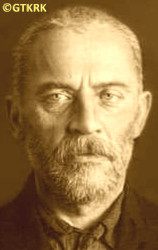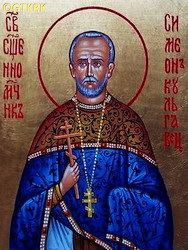Roman Catholic
St Sigismund parish
05-507 Słomczyn
85 Wiślana Str.
Konstancin deanery
Warsaw archdiocese, Poland
full list:
displayClick to display full list

searchClick to search full list by categories
wyświetlKliknij by wyświetlić pełną listę po polsku

szukajKliknij by przeszukać listę wg kategorii po polsku

Martyrology of the clergy — Poland
XX century (1914 – 1989)
personal data
religious status
saint
surname
KULHAWIEC
forename(s)
Simeon (pl. Symeon)

canonisation date
14.08.2000

Council of Bishops of the Russian Orthodox Churchmore on
en.wikipedia.org
[access: 2020.09.24]
function
presbiter (i.e. iereus)
creed
Eastern Orthodox Church ORmore on
en.wikipedia.org
[access: 2014.09.21]
date and place
of death
21.02.1938

Butovotoday: Vidnoye reg., Moscow oblast, Russia
more on
en.wikipedia.org
[access: 2020.07.31]
details of death
During World War I after Russian defeat by German and Austro–Hungarian troops at battle of Gorlice in 05.1915, escaped with all the Orthodox priests in Biała Podlaska and millions of Russian officials, teachers, military personnel, etc., i.e. members of the Russian administration in Russian–occupied Poland, deep into Russia (so‐called bezhenstvo).
For a year lived as refugee in Nikolo–Peshnoshsyi monastery, c. 200 km north of Moscow.
Next moved to Moscow and got married.
In 1930 became Russian Orthodox priest.
On 18.01.1938 arrested by the agents of Russian genocidal NKVD organization.
Jailed in Butyrki prison in Moscow.
Accused of „anti–Russian propaganda”. Pleaded not guilty to the charges levied.
On 11.02.1938 sentenced to death by Russian genocidal kangaroo court known as «NKVD Troika».
Murdered in a mass execution.
cause of death
mass murder
perpetrators
Russians
sites and events
11.08.1937 Russian genocideClick to display the description, Great Purge 1937Click to display the description, ButovoClick to display the description, Moscow (Butyrki)Click to display the description
date and place
of birth
02.02.1882

Łomazytoday: Łomazy gm., Biała Podlaska pov., Lublin voiv., Poland
more on
en.wikipedia.org
[access: 2020.09.24]
parents
KULHAWIEC Damian
🞲 ?, ? — 🕆 1885, ?

🞲 ?, ? — 🕆 ?, ?
presbyter (holy orders)
ordination
1930

positions held
1930 – 1938
parish priest — Yakottoday: Yakot, Dmitrov reg., Moscow oblast, Russia
more on
ru.wikipedia.org
[access: 2024.01.29] ⋄ Nativity of the Blessed Virgin Mary OR parish
1930 – 1938
administrator — Timonovotoday: Yakot, Dmitrov reg., Moscow oblast, Russia
more on
ru.wikipedia.org
[access: 2024.01.29] ⋄ Nativity of Christ OR parish
1930
presbiter (Eng. priest, i.e. iereus) — Russian Orthodox Church — priesthood cheirotonia, i.e. ordination
1925 – 1930
psalmist — Orudevotoday: Dmitrov, Dmitrov reg., Moscow oblast, Russia
more on
ru.wikipedia.org
[access: 2024.01.29] ⋄ Intercession of the Blessed Virgin Mary OR church
1922 – 1925
psalmist — Dulovotoday: Ruchi, Konakovo reg., Tver oblast, Russia
more on
ru.wikipedia.org
[access: 2024.01.29] ⋄ Image of Edessa OR church
1917 – 1922
policeman — Moscowtoday: Moscow city, Russia
more on
en.wikipedia.org
[access: 2020.07.31]
till 1915
psalmist — Biała Podlaskatoday: Biała Podlaska city pov., Lublin voiv., Poland
more on
en.wikipedia.org
[access: 2021.08.20] ⋄ Nativity of the Blessed Virgin Mary OR church
student — Jabłecznatoday: Sławatycze gm., Biała Podlaska pov., Lublin voiv., Poland
more on
en.wikipedia.org
[access: 2021.12.18] ⋄ School of Conductors and Psalmists ⋄ St Onuphrius OR monastery (stavropegial) — prob.
married
others related
in death
CAKULClick to display biography Michael, NIKATOWClick to display biography Alex, SAWICKIClick to display biography Yaroslav, SIENKIEWICZClick to display biography Alex, MIEDWIEDIUKClick to display biography Vladimir, STEPANIUKClick to display biography George, HUTKOClick to display biography Basil (Bp Ambrose), OSTROUMOWClick to display biography Michael (Bp Seraphim), GAGALUKClick to display biography Anthony (Abp Onuphrius), STROCIUKClick to display biography Leontius, BLUMOWICZClick to display biography John, SZACHMUĆClick to display biography Roman (Fr Seraphim), PANASIEWICZClick to display biography Emilian, SMOLENIECClick to display biography Alexander (Abp Arsenius), MARCENKOClick to display biography Alexander (Abp Anthony), BORZAKOWSKIClick to display biography Alexander (Abp Agapit), DIERNOWClick to display biography Anatol (Abp Abramius)
sites and events
descriptions
11.08.1937 Russian genocide: On 11.08.1937 Russian leader Stalin decided and NKVD head, Nicholas Jeżow, signed a «Polish operation» executive order no 00485. 139,835 Poles living in Russia were thus sentenced summarily to death. According to the records of the „Memorial” International Association for Historical, Educational, Charitable and Defense of Human Rights (Rus. Международное историко‐просветительское, правозащитное и благотворительное общество „Мемориал”), specialising with historical research and promoting knowledge about the victims of Russian repressions — 111,091 were murdered. 28,744 were sentenced to deportation to concentration camps in Gulag. Altogether however more than 100,000 Poles were deported, mainly to Kazakhstan, Siberia, Kharkov and Dniepropetrovsk. According to some historians, the number of victims should be multiplied by at least two, because not only the named persons were murdered, but entire Polish families (the mere suspicion of Polish nationality was sufficient). Taking into account the fact that the given number does not include the genocide in eastern Russia (Siberia), the number of victims may be as high as 500,000 Poles. (more on: en.wikipedia.orgClick to attempt to display webpage
[access: 2016.03.14])
Great Purge 1937: „Great Terror” (also «Great Purge», also called „Yezhovshchyna” after the name of the then head of the NKVD) — a Russian state action of political terror, planned and directed against millions of innocent victims — national minorities, wealthier peasants (kulaks), people considered opponents political, army officers, the greatest intensity of which took place from 09.1936 to 08.1938. It reached its peak starting in the summer of 1937, when Art. 58‐14 of the Penal Code about „counter‐revolutionary sabotage” was passed , which became the basis for the „legalization” of murders, and on 02.07.1937 when the highest authorities of Russia, under the leadership of Joseph Stalin, issued a decree on the initiation of action against the kulaks. Next a number of executive orders of the NKVD followed, including No. 00439 of 25.07.1937, starting the liquidation of 25,000‐42,000 Germans living in Russia (mainly the so‐called Volga Germans); No. 00447 of 30.07.1937, beginning the liquidation of „anti‐Russian elements”, and No. 00485[2] of 11.08.1937, ordering the murder of 139,835 people of Polish nationality (the latter was the largest operation of this type — encompassed 12.5% of all those murdered during the «Great Purge», while Poles constituted 0.4% of the population). In the summer of 1937 Polish Catholic priests held in Solovetsky Islands, Anzer Island and ITL BelbaltLag were locked in prison cells (some in Sankt Petersburg). Next in a few kangaroo, murderous Russian trials (on 09.10.1937, 25.11.1937, among others) run by so‐called «NKVD Troika» all were sentenced to death. They were subsequently executed by a single shot to the back of the head. The murders took place either in Sankt Petersburg prison or directly in places of mass murder, e.g. Sandarmokh or Levashov Wilderness, where their bodies were dumped into the ditches. Other priests were arrested in the places they still ministered in and next murdered in local NKVD headquarters (e.g. in Minsk in Belarus), after equally genocidal trials run by aforementioned «NKVD Troika» kangaroo courts.
Butovo: Russian genocidal NKVD shooting range n. Moscov. From 08.08.1937 place of mass executions (during Great Purge). Till 19.10.1938 there were murdered 20,765 people (95.86% men), including 1,176 Poles — according to fragmentary available data. Among the executed were 739 Russian Orthodox priests, including 7 bishops and Metropolitan bishops with 81 years old Metropolitan bishop Seraphim Chichagov, today the saint of Orthodox church (this church canonised 255 of the victims), and Lutheran and Protestant pastors and Catholic priests, mainly from Poland and Austria. Place known today and „Russian Golgotha”. (more on: en.wikipedia.orgClick to attempt to display webpage
[access: 2020.07.31])
Moscow (Butyrki): Harsh transit and interrogation prison in Moscow — for political prisoners — where Russians held and murdered thousands of Poles. Founded prob. in XVII century. In XIX century many Polish insurgents (Polish uprisings of 1831 and 1863) were held there. During Communist regime a place of internment for political prisoners prior to a transfer to Russian slave labour complex Gulag. During the Great Purge c. 20,000 inmates were held there at any time (c. 170 in every cell). Thousands were murdered. (more on: en.wikipedia.orgClick to attempt to display webpage
[access: 2020.05.01])
sources
personal:
pl.wikipedia.orgClick to attempt to display webpage
[access: 2021.12.19], drevo-info.ruClick to attempt to display webpage
[access: 2020.09.24], ru.openlist.wikiClick to attempt to display webpage
[access: 2024.01.29], www.pstbi.ccas.ruClick to attempt to display webpage
[access: 2020.09.24]
bibliographical:
„Hierachy, clergy and employees of the Orthodox Church in the 19th‐21st centuries within the borders of the Second Polish Republic and post–war Poland”, Fr Gregory Sosna, M. Antonine Troc-Sosna, Warsaw–Bielsk Podlaski 2017
original images:
drevo-info.ruClick to attempt to display webpage
[access: 2020.09.24], azbyka.ruClick to attempt to display webpage
[access: 2024.01.29]
LETTER to CUSTODIAN/ADMINISTRATOR
If you have an Email client on your communicator/computer — such as Mozilla Thunderbird, Windows Mail or Microsoft Outlook, described at WikipediaPatrz:
en.wikipedia.org, among others — try the link below, please:
LETTER to CUSTODIAN/ADMINISTRATORClick and try to call your own Email client
If however you do not run such a client or the above link is not active please send an email to the Custodian/Administrator using your account — in your customary email/correspondence engine — at the following address:

giving the following as the subject:
MARTYROLOGY: KULHAWIEC Simeon
To return to the biography press below:
 Click to return to biography
Click to return to biography









